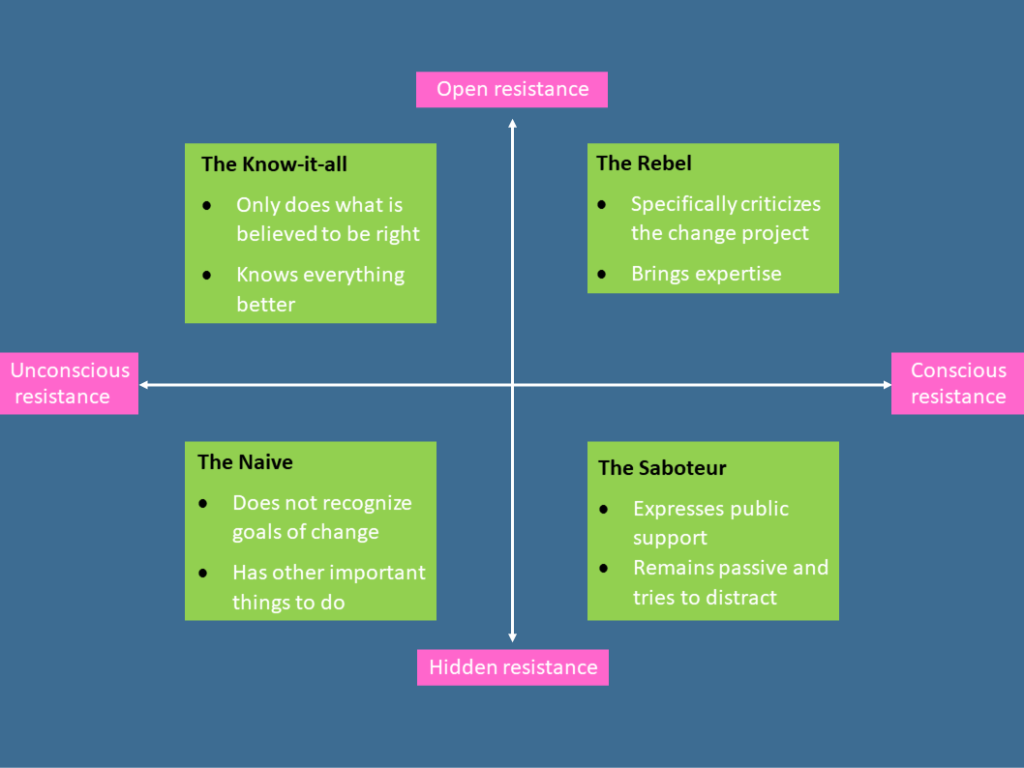The digital transformation is in full swing. Digitalization is not only changing technology and processes, but also the way we work together, i.e., the organization, leadership, and culture in companies. The companies that recognize these connections and continuously develop them are successful in the changes. But the reality is also: Many of these transformation projects fail, do not have the expected successes or are still waiting, because the associated changes and resistances are seen as too high hurdles. In this post, I would like to discuss the opportunistic resistance of executives in transformations: what is it, how do you recognize this, and how should you deal with it? This is the translation of an article that was published in the German „HR Journal“.
In a transformation project, you will involve your managers and other key players at an early stage. Managers are usually familiar with change projects and know from other companies that digital transformation entails major changes for them. These changes are greatest for executives. Starting with the need to learn new technologies, tools, to work with other processes and responsibilities and often also to adapt to a new leadership model. The loss of prestige, influence, power, or money is feared. Every executive also knows examples from digital projects in other companies, where jobs or even entire levels of executives have been cut. In this starting position, your managers are at least reserved, if not afraid, about accompanying or helping to shape the digital transformation.
What types of resistance are there?
As you discuss your transformation initiative with your leaders, you may encounter the following negative reactions (in addition to positive and supportive ones, which I won’t go into now), which I’ve divided into three „clusters.“
- Appeasing or evading:
- We don’t have time for that, we have too much to do
- Everything is going well, we must take care of our business
- We should first tackle issues A, B and C before we do that.
- That doesn’t help, it doesn’t make us better
- We need digitization, but we currently have more important topics.
- Necessity is questioned:
- Too much effort, too little improvement
- We should wait until technology/software is more mature
- We have already discussed this several times and rejected it for good reasons.
- Threat scenarios are constructed:
- If we do that, then the employees jump off us
- Our customers do not want this (e.B. no chatbots) and we lose massive customers as a result
- In company X, Y similar projects have failed.
Although I have provided it with negative headlines at the top. These feedbacks may be correct in parts. In addition, they are a mirror of the emotional state of your managers. And especially at the beginning of a change process, the resistance expressed in this way is not only conscious, but also happens unconsciously.
A good outline of the resistance provides the following diagram.[1] I find the division into a conscious/unconscious and open/hidden resistance revealing. Rebels, know-it-all, naïve and saboteurs you will probably know from past initiatives. My experience is that you can best win rebels and naïve people for a transformation project. Convincing know-it-alls is more difficult, because they are (too) convinced of themselves, often there is a lack of willingness to reflect on other arguments as important and to adapt one’s own attitude. The saboteur is the most difficult group, because here a conscious undermining takes place in secret. The saboteur is the main source of opportunist resistance. But saboteurs can also be won over to the need for change.

How do you recognize opportunist resistance?
But how do you find reliablesupporters, and how do you recognize opportunist resistance? The following points might help:
- Who actively participates in the discussion, who is more passive or even missing (more frequently)?
- Who gets involved in an argumentative level and is willing to discuss along problems?
- Who not only supports, but also contributes their own ideas, shows interest or even enthusiasm?
- Who weighs superficially and does not respond to arguments?
- Who usually argues from the first-person perspective and not from the corporate perspective?
- Who remains in the above-mentioned patterns of dissent, doubt, or threat, even if the points have been refuted with good arguments?
- Who remains in problem mode and does not open for solutions?
- Who discusses irritably or even aggressively and is not open to feedback?
- The body language is revealing disinterest and rejection is clearly recognizable.
Over time, it becomes clear who you can rely on, or who may even be on the road as a saboteur. It helps if you systematically record who shows openness in the meetings, discusses along the arguments, does not deviate, does not initiate distraction manoeuvres, participates in the discussion, is constructive and reflective. And who doesn’t. You should have one-on-one conversations if you feel that someone is playing dishonestly and exploring the motives. Moderation and coaching competencies foster the process of convincing your team. In addition to recognizing tactical manoeuvres, you must discuss problems in their context, stay on the ball, stick to solutions, and not jump from problem A to B and C.
How you should deal with resistance
- In the beginning is the realization that every change is associated with resistance, it is therefore „normal“.
- For me, it is important that you start from a positive image of people and thus rely on persuasiveness. This appreciative approach is the prerequisites for making your efforts credible to let your people contribute to the change.
- On the other hand, do not naively approach your team and recognize the managers who can endanger an implementation project. At the same time, you must trust in the managers who bring a project forward at an early stage
- Successful transformations are led by the top, if only because only from there the necessary „sense-of-urgency“ is conveyed.
- In addition, good preparation is required. Discuss your project at the beginning in the circle of your confidants. Put yourself in the position of your managers and employees (change of perspective). What reactions can be expected? What fears are there, why do we need the changes? Play through the above reactions and create good answers for the points. Develop a transformation story that convinces rationally and emotionally. Designing change processes means taking people along and convincing them.
- Even if you’ve developed a good transformation story, be open to change if arguments convince you. Constructive and reflective behaviour wants to be exemplified.
- Despite all the openness, points must not be discussed for too long. If you are convinced that you must digitize now, the “whether” should no longer be questioned, but only the „How do we get there?“.
- You can ask executives to go into solution mode and to offer solution options when pointing out problems only.
- It helps to be fact based, argumentative and analytical in the discussions. Targeted use of emotionality supports the topics that are particularly important to you.
- Because change processes relate to fear, you should respond empathetically to these fears and, as far as possible, offer security. If no security is possible, you should offer options or socially acceptable solutions, e.g., expert functions, if someone wants to get out of the leadership role. How they deal with their managers radiates to the entire workforce.
- Regardless of this, my advice is to quickly part with managers who do not want to participate in these changes; Saboteurs are putting your project and maybe even the future of your business at risk. By the way, employees have a high level of acceptance if you part with these managers. They have usually also experienced them as bad managers.
[1] The overview can be found in a very good chart set for me on the subject of „Change Management“ – in German https://www.cobocards.com/pool/de/card/5wem01215/online-karteikarten-4-typen-von-widerstandskaempfern-typennennung-4-grafik-2-/

1 Kommentar on “How to deal with resistance of executices in transformation projects”